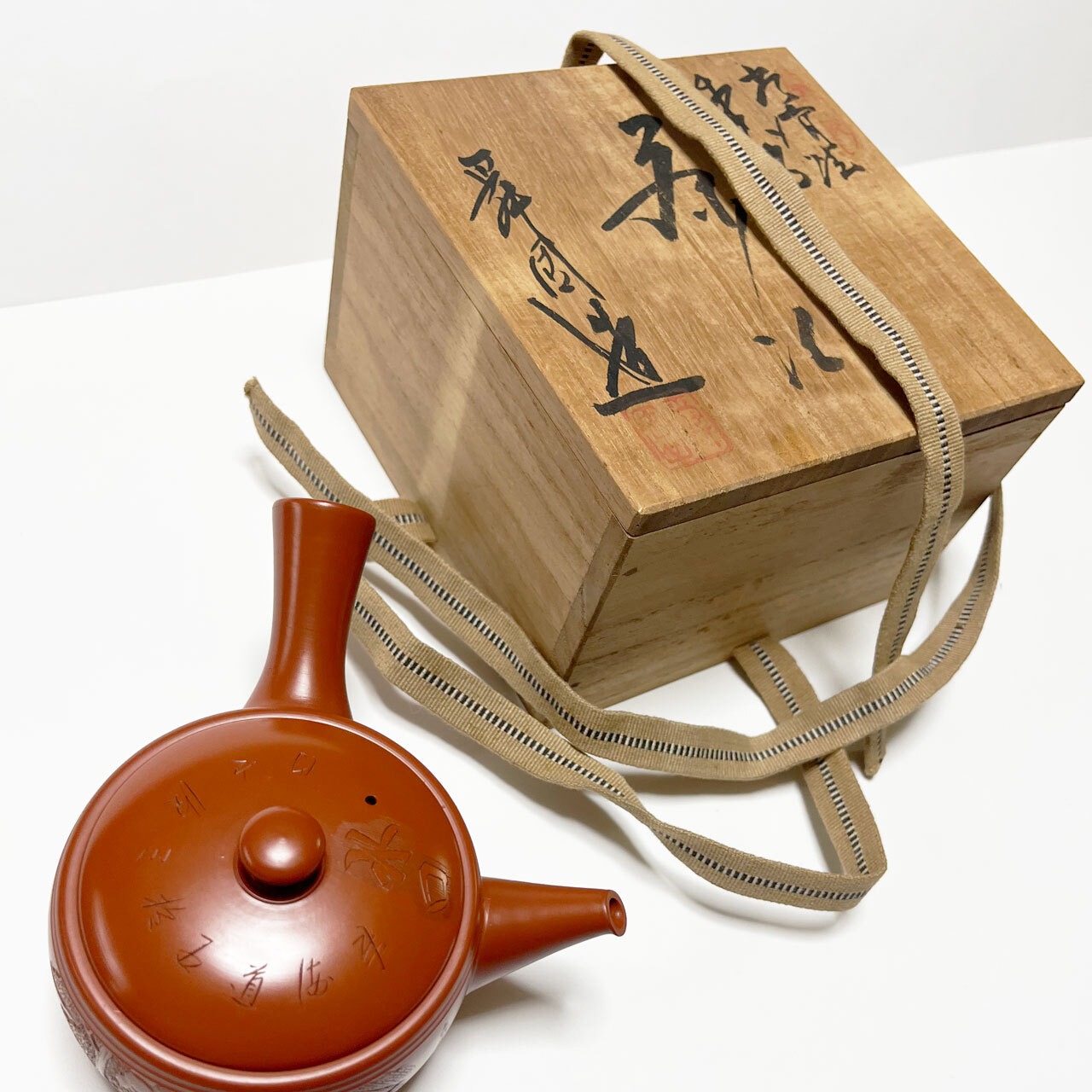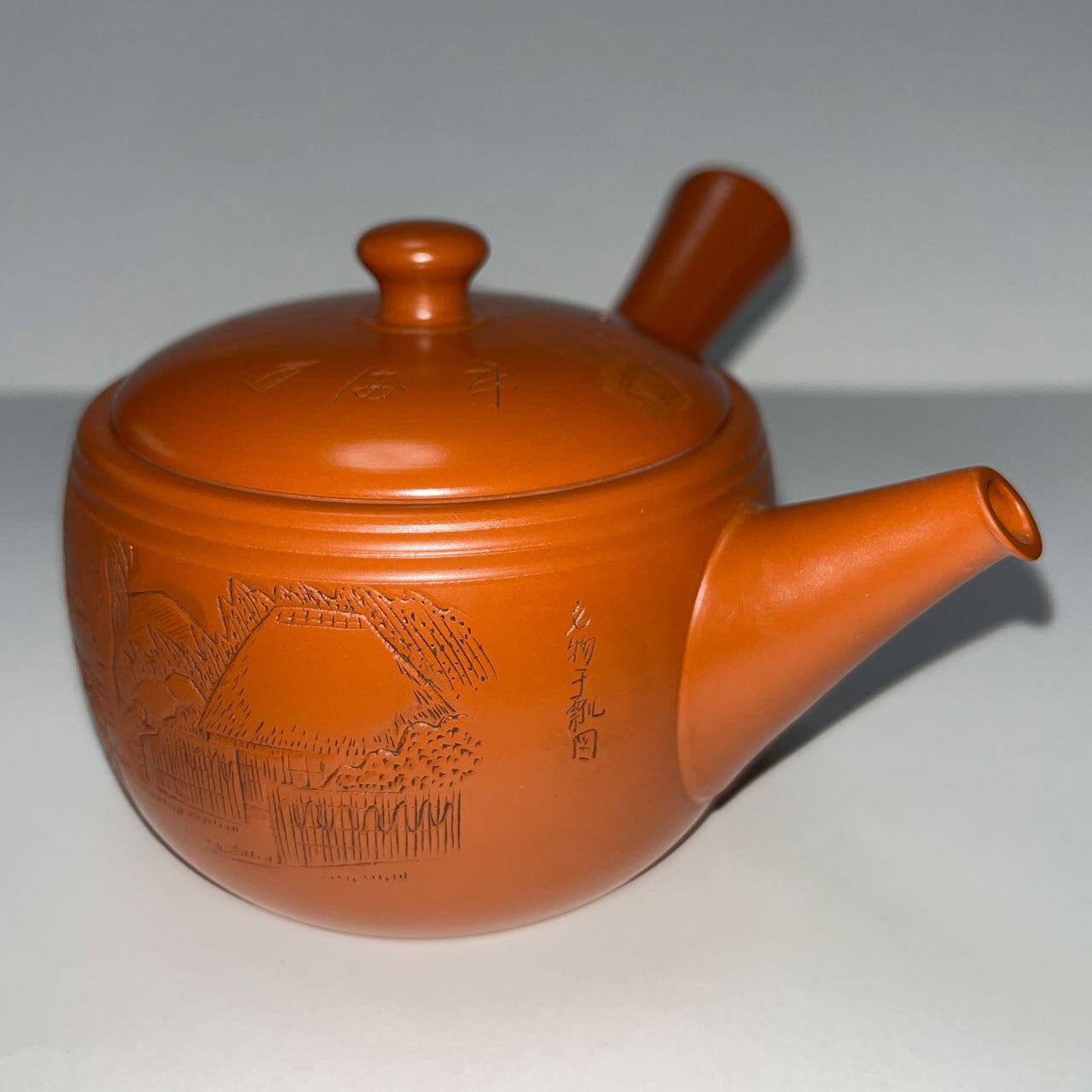








常滑焼 「東海道五十三次 水口 名物干瓢」の彫刻急須 初代間野舜園作 新品・未使用品 共箱あり / Tokoname-yaki, "Tokaido-Gojusan-tsugi, Minakuchi Meibutsu-Kanpyo-zu", Created by Shunen Mano, New/unused item, Original box
¥70,000 税込
残り1点
歌川広重の「東海道五十三次 水口 名物干瓢」が彫刻された急須は、伝統と美が織りなす特別な一品です。この急須は、初代間野舜園の手によって丁寧に作られており、使うたびに心温まる体験を提供します。美しい彫刻が施されたこの急須は、見る者を魅了するだけでなく、心地よい重さがあり、手にしっくりと馴染みます。
急須には精密な彫刻がほどこされており、そのデザインは日常の中に伝統文化を感じさせてくれます。また、この急須は耐熱性にも優れており、安心してお茶を淹れることができます。お茶を注ぐ瞬間が、特別なひとときに変わり、心豊かな時間を演出します。
さらに、シンプルで美しいデザインはインテリアとしても楽しむことができ、和の趣を添えることでしょう。贈り物としても喜ばれること間違いありません。この急須を通じて、日本の伝統と美を感じ、毎日の生活を特別なものにしてみませんか。
※新品・未使用品、小売店で眠っていた不動在庫(長期保管品)です。
---------------------------------
Q:常滑焼(とこなめやき)とは?
A:常滑焼は、日本の愛知県常滑市を中心とした陶磁器の伝統的な窯元です。「日本六古窯(にほんろっこよう)」(瀬戸・常滑・信楽・丹波・備前・越前)と呼ばれています。平安時代末期には、知多半島の丘陵地に常滑を中心に穴窯が広がり、山茶碗や壺などが作られました。この時代に作られた焼き物は古常滑と呼ばれます。中世常滑窯は当時最大の生産地で、大型の皿や茶碗が特徴でした。室町時代には生産が拡大し、大型の甕や壺が遠隔地へ船で運ばれました。江戸時代には真焼けの陶芸品が増え、明治時代には平地窯や機械化が導入され、食塩焼きが現れ、土管・焼酎瓶・建築陶器、衛生陶器も登場し、近代産業へ進化しました。大正から平成にかけて技術と生産が急速に進歩し、現在の状況に至りました。
Q:初代間野舜園(まの しゅんえん)とは?
A:常滑の朱泥急須は渋みを抑えた温かみのある器として知られますが、初代間野舜園はこれに「立体彫り」を施した先駆者です。戦後まもなく、常滑に訪れていた彫師・牛島一陶との出会いがきっかけとなり、急須に大胆な彫刻を加える技法を開発しました。初代舜園の跡は、1974年に二代舜園(本名:間野昇、1950年生)が継いでいます。
Q:東海道五十三次 水口 名物干瓢とは?
A:「東海道五十三次 水口 名物干瓢」は、本来は江戸時代の著名な浮世絵師、歌川広重によって制作された浮世絵で、1833年から1834年にかけて描かれました。干瓢(かんぴょう)、すなわち夕顔(ゆうがお)の果皮を細く剥いて天日で干す加工風景を表現した作品で、現在の滋賀県甲賀市にある水口の代表的特産品を象徴しています。
===================
This teapot engraved with Hiroshige Utagawa(歌川広重)'s "Tokaido-Gojusan-tsugi, Minakuchi Meibutsu-Kanpyo-zu(東海道五十三次 水口 名物干瓢)" is a special item that combines tradition and beauty. This teapot was carefully crafted by the first generation Mano Shunen, and provides a heartwarming experience every time you use it. Not only does this beautifully carved teapot captivate the viewer, but it also has a comfortable weight and fits comfortably in the hand.
The teapot is precisely carved, and its design gives you a sense of traditional culture in your daily life. This teapot is also highly heat-resistant, so you can brew tea with peace of mind. The moment you pour tea turns into a special moment, creating a rich time.
In addition, the simple and beautiful design can be enjoyed as an interior decoration, adding a touch of Japanese charm. It is sure to be a welcome gift. Why not feel the tradition and beauty of Japan through this teapot and make your daily life special?
*New/unused item. This is a long-term storage item at a retail store.
---------------------------------
Q : What is Tokoname-yaki?
A : Tokoname-yaki is a traditional pottery pottery centered in Tokoname City, Aichi Prefecture, Japan. At the end of the Heian period (794-1185), anagama kilns spread across the hills of the Chita Peninsula around Tokoname, known as the "Six Ancient Kilns of Japan" (Seto, Tokoname, Shigaraki, Tanba, Bizen, and Echizen). Tea bowls and pots were made. Pottery made in this period is called Ko-Tokoname. Medieval Tokoname kiln was the largest production area at that time, and was characterized by large plates and bowls. During the Muromachi period, production expanded, and large-scale jars and pots could be obtained by ship to remote areas. In the Edo era, the number of ceramics made with true ware increased, and in the Meiji period, flat kilns and mechanization were introduced, salt-grilled products appeared, clay pipes, shochu bottles, architectural ceramics, and sanitary wares appeared, evolving into a modern industry. Technology and production progressed rapidly in the future, leading to the current situation.
Q: Who was the first Mano Shunen?
A: Tokoname red clay teapots are known for their warmth and subdued bitterness, but Mano Shun'en I was the pioneer who applied "three-dimensional carving" to them. Shortly after the war, he met the carver Ushijima Itto, who was visiting Tokoname, and developed a technique for adding bold carvings to teapots. Shun'en II (real name: Mano Noboru, born in 1950) took over from the first in 1974.
Q: What is "Tokaido-Gojusan-tsugi, Minakuchi Meibutsu-Kanpyo-zu(東海道五十三次 水口 名物干瓢)"?
A: "Tokaido-Gojusan-tsugi, Minakuchi Meibutsu-Kanpyo-zu" is an ukiyo-e print originally created by the famous Edo period ukiyo-e artist Utagawa Hiroshige(歌川広重) between 1833 and 1834. This work depicts the process of making dried gourd, in which the skin of the bottle gourd is peeled into thin strips and dried in the sun, and symbolizes a representative specialty of Minakuchi, located in what is now Koka City, Shiga Prefecture.
*"Tokaido(東海道)" is one of the major roads developed during the Edo period, and is approximately 490 kilometers long, connecting Edo (present-day Tokyo) to Kyoto. This road passed through 53 post towns (stations) and functioned as an important transportation route for travelers and merchants. Because there are 53 post towns, it is called the "Tokaido-Gojusan(53)-tsugi".
-
送料・配送方法について
-
お支払い方法について































